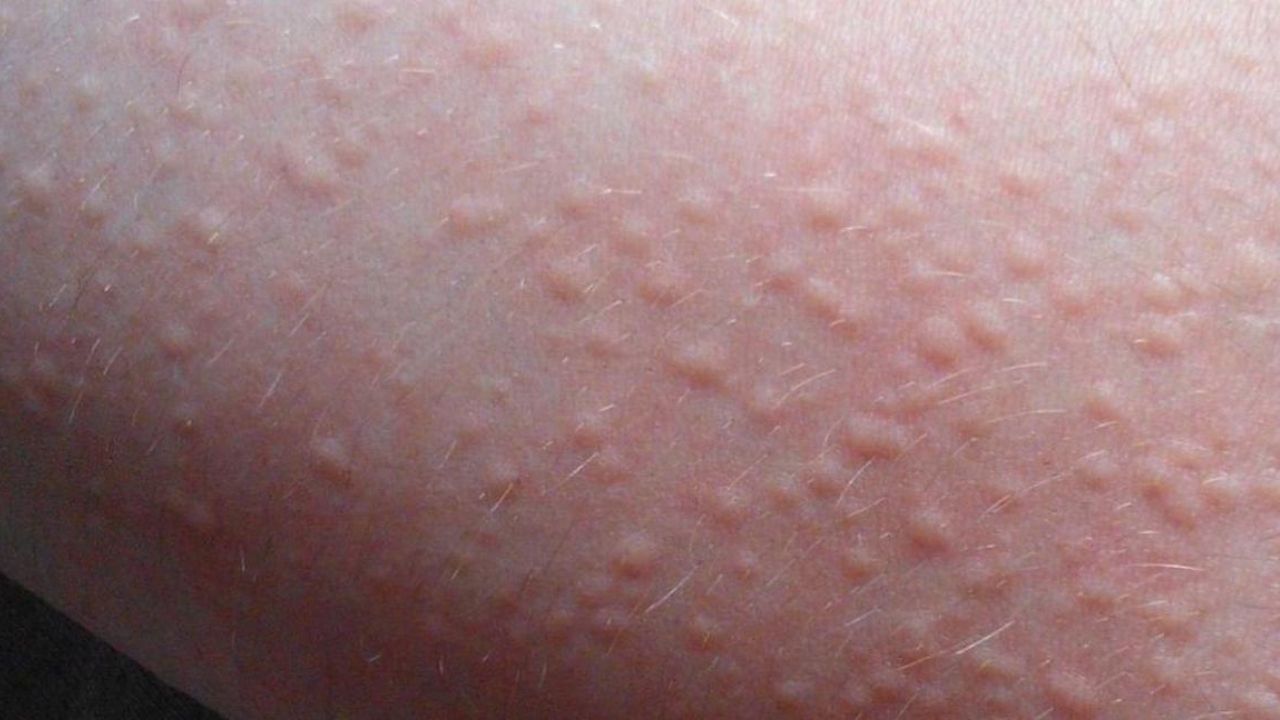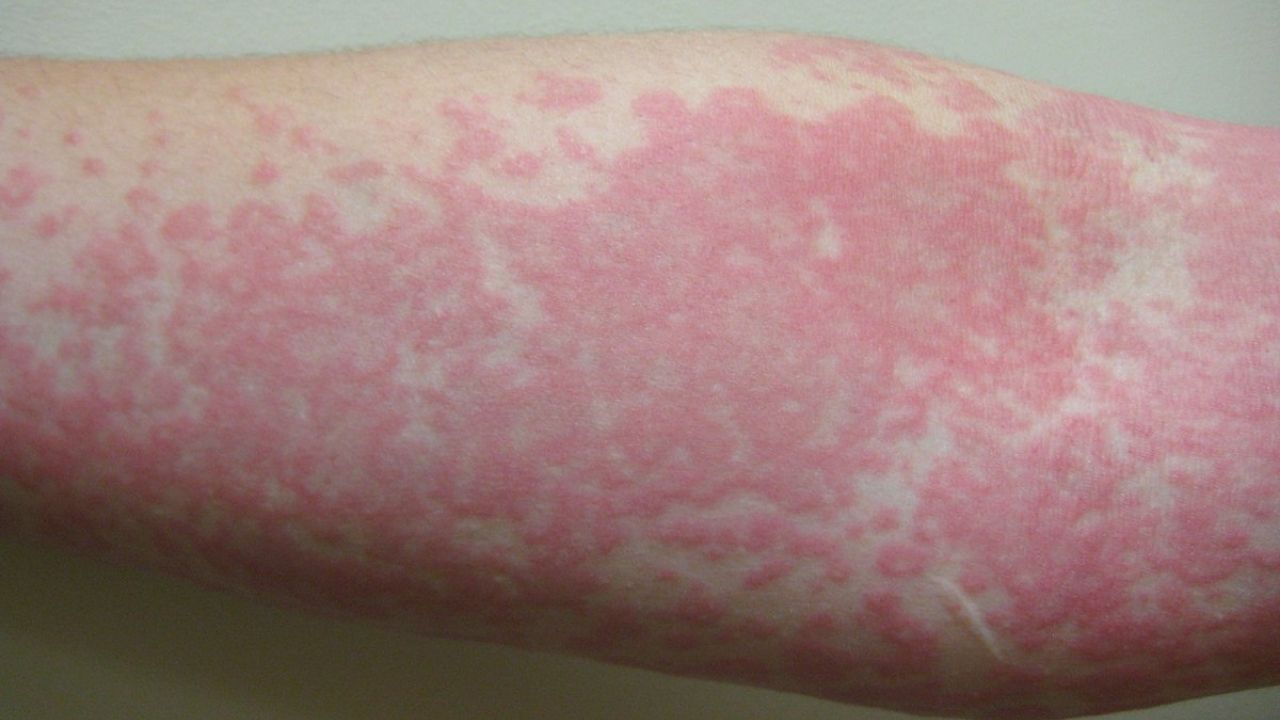Urticaria, or hives, is an acute or chronic condition that is often pruritic and presents with an erythematous (red, pink), painless, blistering rash that usually disappears within 24 hours and leaves behind clear skin.

Typical features of urticaria include:
- rashes in the form of blisters, spots and swelling,
- the presence of itching (there may be only itching without a rash or a rash without itching),
- painless rash (concomitant Quincke’s edema can be painful),
- individual rashes disappear within 1 day, leaving behind “clear skin”. If individual blisters persist for more than 1 day and / or after they remain peeling, pigmentation, etc. residual effects, it may be another disease resembling urticaria, for example, urticarial vasculitis.
The prevalence of urticaria. Urticaria is a very common disease that affects 15-25% of people worldwide (occurs at least 1 episode in a lifetime), with acute urticaria accounting for more than 60% of all cases.
Causes of urticaria
Hives are not always allergic, as many believe. Most cases of the disease are associated with the action of various factors, many of which are currently generally unknown. However, scientists suggest that urticaria often occurs only as a “symptom” of another disease that causes it. And indeed it is.
Urticaria is often noted and associated with infections, diseases of the gastrointestinal tract, diseases of the liver, pancreas and thyroid glands, parasitic invasions, rheumatic and autoimmune diseases, tumors, etc.
It is important that the most common causes of acute and chronic urticaria are fundamentally different.
Causes of acute urticaria
Acute urticaria is often allergic and usually develops due to hypersensitivity reactions to a specific allergen from the external environment. Thus, most cases of acute urticaria and / or angioedema are allergic and proceed by an immune mechanism associated with the synthesis of class E antibodies (IgE).
The most common urticaria allergens are:
- medicines, for example, antibiotics (penicillins, sulfonylamides, and others), non-steroidal anti-inflammatory drugs (NSAIDs such as aspirin), muscle relaxants, diuretics, and others;
- food (both through direct contact with the skin and when ingested; for example, milk, eggs, peanuts, nuts, seafood, fish);
- insect bites / stings;
- contact with other allergens and substances (for example, latex, rubber, animal saliva, plants, etc).
Sometimes acute urticaria proceeds by other immune mechanisms (not associated with IgE production):
- when using a certain type of drug (for example, opioids, beta-blockers, vancomycin, NSAIDs) or eating food;
- the use of radio-opaque substances;
- with acute viral infections (especially in children);
- for other reasons (rheumatic diseases, hormonal disorders, etc).
The causes of chronic urticaria
Unfortunately, in 70-90% of cases, the cause of chronic recurrent urticaria in adult patients remains unknown and the disease is considered idiopathic, that is, without an identified cause. Chronic urticaria is much less common in children than in adults and its cause is identified much more often.
In 30-50% of patients, chronic urticaria / angioedema are autoimmune in nature and may be associated with other autoimmune diseases, for example, with thyroid disease – autoimmune thyroiditis.
Scientists believe that in about 40-60% of cases of chronic urticaria with an undiagnosed cause, the disease is associated with known or so far unknown to science autoimmune processes, in all the rest it is “true” idiopathic (ie, without an identified cause and without an autoimmune background).
In addition, there are diseases that have now ceased to be attributed to urticaria, although they are very similar to it (for example, urticarial vasculitis, cutaneous mastocytosis – urticaria pigmentosa and others).
Signs of urticaria
- itching
- blisters
- spots,
- redness of the skin (erythema),
- Quincke’s edema is possible,
- sometimes in the area of edema there is tension in the skin, some soreness,
- burning, pain in the area of the rash is more characteristic of urticarial vasculitis.
Diagnosis of urticaria
Despite the similarity of symptoms, the approach to diagnosis for acute and chronic urticaria is different. Laboratory tests are sometimes necessary to identify the cause of chronic and intermittent (episodic) acute urticaria.
In most cases, the diagnosis is based on the history (medical history) and examination of the patient.
Contact / referral to a specialist (allergist-immunologist) is necessary in many cases of chronic urticaria to draw up a diagnostic plan (search for the main cause of the disease) and select a treatment.
If allergic urticaria is suspected, it is possible to conduct an allergic study (skin tests and the determination of specific antibodies in the blood). To exclude concomitant pathology in chronic urticaria / angioedema, the range of examination is determined by the allergist in each case individually.
Unfortunately, the cause of chronic urticaria and / or angioedema in most cases, even after extensive examination, is not identified. But such a patient remains under further medical supervision to detect the symptoms of the disease that causes the urticaria, to correct therapy in anticipation of spontaneous remission (cure) of the urticaria.
Diseases similar to urticaria
There are several conditions that have symptoms that resemble hives:
- urticarial vasculitis,
- urticaria pigmentosa (mastocytosis),
- hives during pregnancy
- drug reactions,
- atopic dermatitis,
- contact dermatitis,
- erythema multiforme,
- anaphylactoid purpura,
- scabies.
Urticaria treatment
Medicines “for urticaria”, in particular antihistamine tablets, can save the patient from the painful manifestations of the disease, lead to an increase in the quality of life. The main methods and types of treatment for urticaria include:
- antihistamines: acting on H1 receptors (1st and 2nd generation) and H2 histamine receptors. Antihistamines are the first choice for the treatment of both acute and chronic urticaria. Immunomodulators (for example, prednisone, cyclosporine, etc.) are indicated for only a small number of patients with chronic urticaria,
- immunomodulators (including glucocorticosteroid drugs (the so-called “hormonal” drugs, cyclosporine and others),
- antagonists of leukotriene receptors,
- some others.
Angioedema in the face, throat, or neck area can cause airway obstruction and may require immediate adrenaline (epinephrine) administration.
Treatment for chronic urticaria depends on whether or not the underlying underlying condition has been identified. If such a disease is identified, then first of all, its treatment is carried out.
Important
Urticaria may be accompanied by Quincke’s edema (angioedema, the old name is angioedema). Angioedema is edema involving the deep layers of the skin in the pathological process.
According to statistics, in 50% of cases, urticaria occurs in isolation, 40% of patients with urticaria develop Quincke’s edema and 10% of patients develop angioedema without urticaria.
Some patients are sincerely mistaken, believing that Quincke’s edema is only swelling of the face or throat. Angioedema really often occurs in the face area, but this does not mean that it cannot appear on the hands, feet and other parts of the body.
